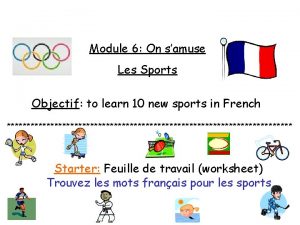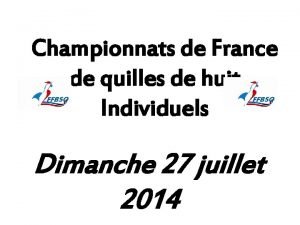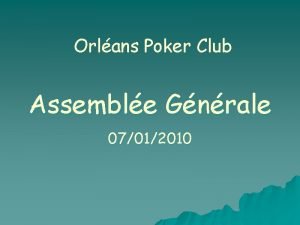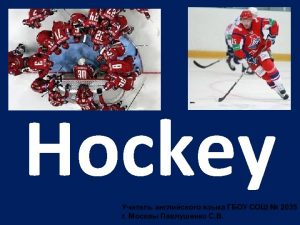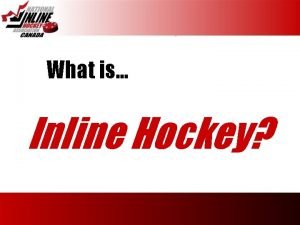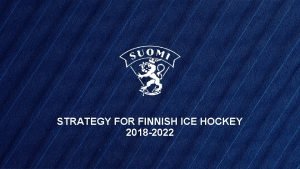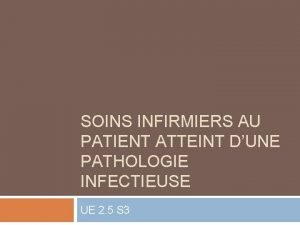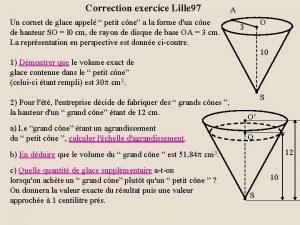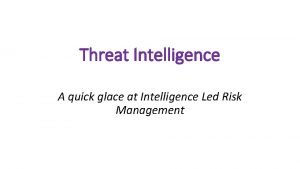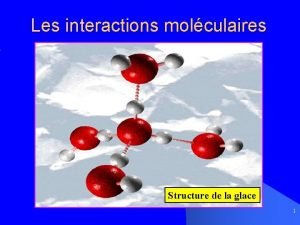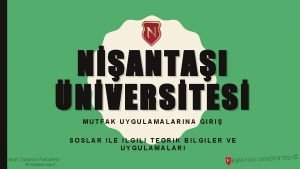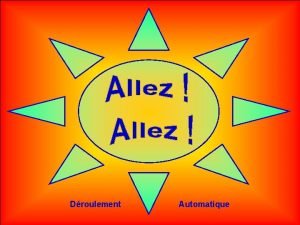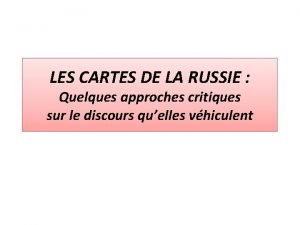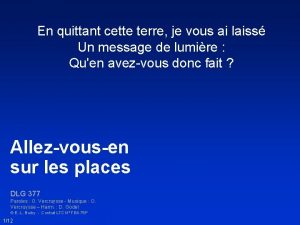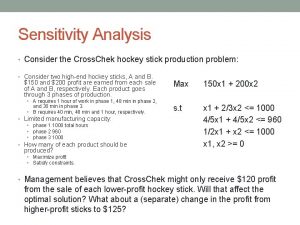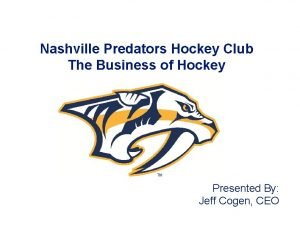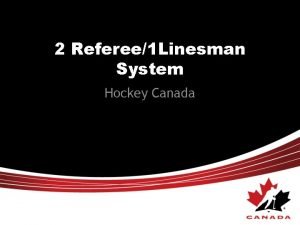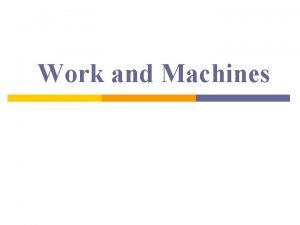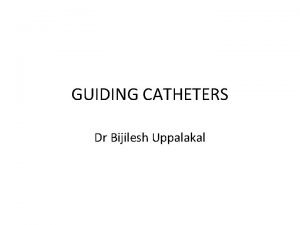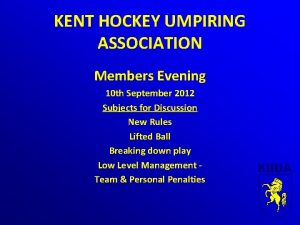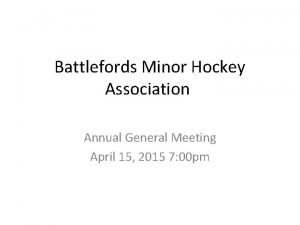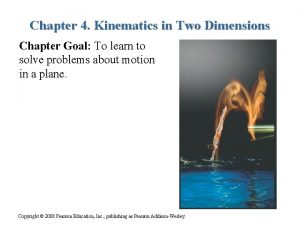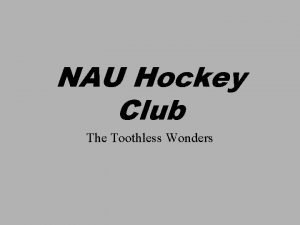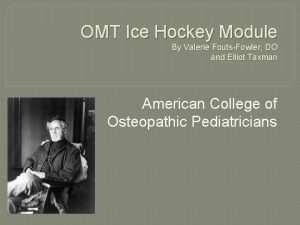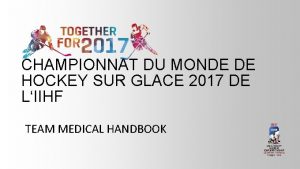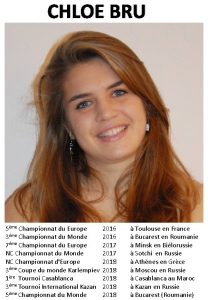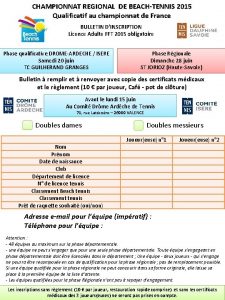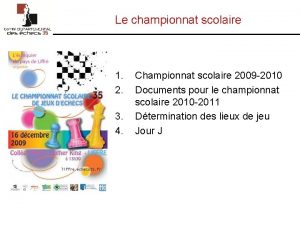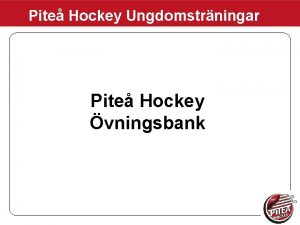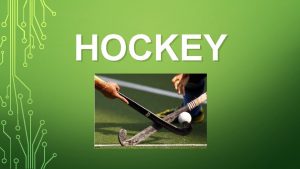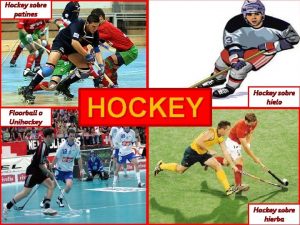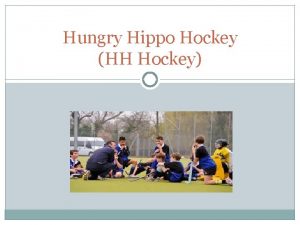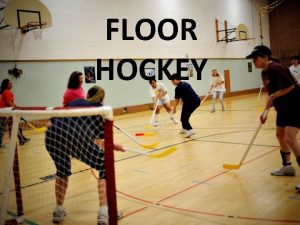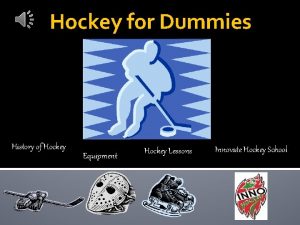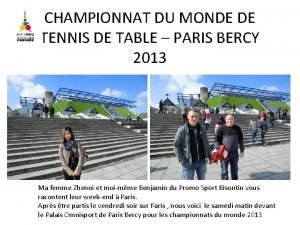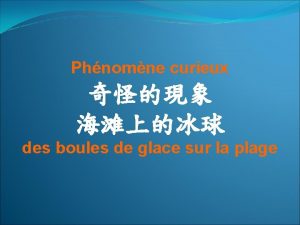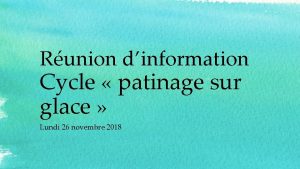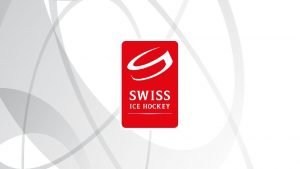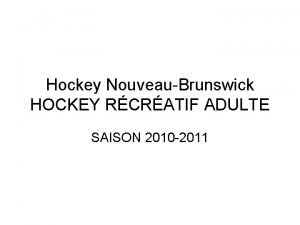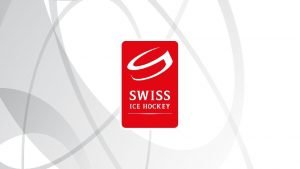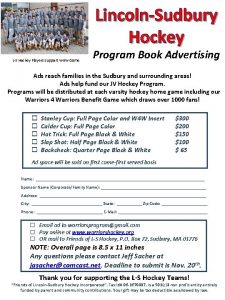CHAMPIONNAT DU MONDE DE HOCKEY SUR GLACE 2017
































- Slides: 32

CHAMPIONNAT DU MONDE DE HOCKEY SUR GLACE 2017 DE L‘IIHF TEAM MEDICAL HANDBOOK

TABLE OF CONTENTS I. WELCOME LETTER II. MEDICAL ORGANIZING STRUCTURE III. TEAM MEDICAL PERSONNEL MEETING AGENDA IV. MEDICAL POLICIES AND PROCEDURES V. EMERGENCY ACTION PLAN (EAP) VI. DOPING CONTROL VII. APPENDIX

I. WELCOME LETTER Dear Ice Hockey Friends, We would like to warmly welcome you to the cities of Cologne and Paris, the host cites of the 2017 IIHF Ice Hockey World Championship ! We are very pleased to finally have you around after a long road that started back in May 2013, when the IIHF Annual Congress voted for the very first time in favor of a joint bid of two nations, Germany and France. Under the motto “Together for 2017” we gathered a crew of motivated hockey lovers that soon became a team with multinational spirit, ideas and dreams. Now all members of our Organizing Committee are taking great pride in presenting ourselves to you as two different nations, but one common host. Franz Reindl Together with you, your teams, the fans, Asterix and Obelix, we are looking forward to experiencing a unique event, great sport, big emotions and lots of fun during the 2017 IIHF Ice Hockey World Championship in Germany and France. Let’s all celebrate : Together for 2017 ! Ensemble Pour 2017 ! Gemeinsam für 2017 ! Luc Tardif

II. MEDICAL ORGANIZING STRUCTURE

III. TEAM MEDICAL PERSONNEL MEETING AGENDA THURSDAY, MAY 4 TH – 16: 00 Louis Magnus Lounge / ACCORHOTELS ARENA (AHA) Welcome Host organizing commitee medical program services Host organizing commitee services IIHF Injury Reporting System Doping Control Program Medical Policies - IIHF concussion Protocol - Injured Athlete, EAP, Removal from ice procedures - Blood Spill procedures Others

IV. MEDICAL POLICIES AND PROCEDURES 1. ROLE OF HOST PHYSICIANS The primary role of the volunteer physicians is to act as an EVENT PHYSICIAN, which includes: a) Liaise with, and provide support for, the national team physicians in order to ensure the provision of comprehensive local medical care during the event. b) Provide urgent or emergency medical care assistance if necessary. Return to play and fitness to play decisions are the responsibility of the national team physician.

IV. MEDICAL POLICIES AND PROCEDURES 2. MEDICAL PERSONNEL ON SITE All physicians, surgeons, dentists and therapist providing game coverage are licensed to practice in France and are registered as accredited volunteers with the organizing committee. Medical staff will have proper accreditation and outfitting that identifies them accordingly. The primary role of the host medical staff is – as with the physicians – to work with and support the national team medical staff in accessing or delivering care for the athletes. Ø Ø Dr Fabrice Leclerc MD (ECMO From May 4 th to 10 th) Dr Olivier Tricoire MD (ECMO From May 11 th to 18 th) Dr Eric Dopff (Chief Dental Officer) Eric Wadoux (Chief Therapist)

IV. MEDICAL POLICIES AND PROCEDURES 3. AMBULANCE A dedicated ambulance with trained paramedics will be on site at the Accor. Hotels Arena (AHA) for all games, and only on call for practices as it is very close (10 minutes max. ) Paramedics should check with the duty physician prior and the intensive care physician (for the games) to leaving. In most cases the event ambulance will NOT be asked to transport a seriously ill or injured athlete. The event staff will stabilize the athlete and Venue PCO will manage transfer to the Centre Hospitalier Universitaire (CHU) thru emergency system (SAMU de Paris)

IV. MEDICAL POLICIES AND PROCEDURES 4. HOSPITAL & COSTS The Championship Hospital is « Hôpitaux Universitaires La Pitie Salpêtrière » - (2 kms from the AHA) Further information on the hospitals is available in Appendix A. Please be reminded that teams should be prepared to pay or being reinvoiced by the IIHF for any hospital costs (admission, diagnostic imaging, other tests, surgery) at the time the patient is treated, and then be reimbursed by their insurance company.

IV. MEDICAL POLICIES AND PROCEDURES 5. MEDICAL CLINIC AND EQUIPMENTS The medical clinic at the AHA will be open 1 hour prior to and ½ hour following all games and during practices. The duty physician, host surgeon, dentist, and therapist will be available for advice, support and assistance. For non-urgent medical advice, support or assistance when the medical clinic is not activated, please call the chief medical officer. Ø Dr Fabrice Leclerc : +33 642 31 56 77 from May 4 th to 10 th Ø Dr Olivier Tricoire : +33 623 89 93 59 from May 11 th to 18 th

IV. MEDICAL POLICIES AND PROCEDURES 6. MEDICAL CLINIC AND EQUIPMENTS The following medical equipment will be available in the Medical Clinic : - X-Ray Equipment Rafale B DR - Ultrasound scanner Logiq E 9 xd clear - Defibrillator Responder AED - ECG Mac 2000 The following medical equipment will be available in Zimmer Area : - Physio SD Komplet - En. Puls Pro - Thermo TK

IV. MEDICAL POLICIES AND PROCEDURES 7. IMAGING At the venue, immediate x-ray and ultrasonography will be available Any need of more extensive imaging will be referred to our affiliated hospital or an x-ray clinic. Further details will be provided at the Team Medical Meeting.

IV. MEDICAL POLICIES AND PROCEDURES 8. MASSAGE THERAPY A program to allow athletes to have access to massage therapy has been set up for the duration of the Championship. We will have a massage therapist-osteopath available at the venue on a daily basis. Schedule will be posted in the Medical Clinic. Priority will be given to athletes requiring massage for injury recovery, as well as to athletes who have pre-booked their appointments. Please see the Chief Therapist to arrange an appointment.

IV. MEDICAL POLICIES AND PROCEDURES 9. ON-SITE PHARMACY A limited pharmacy of medications (for emergency use only) will be available at the venue. Written prescriptions may be given for medications required beyond an initial supply after consultation between the team and event physicians. Contact information for a local 24 -hour pharmacies is included in the Appendix of this manual. Prescription from any medical doctor, belonging to EU, is valid in France The cost of medication or medical supplies that are not available at the Medical Clinic is the responsibility of each team.

IV. MEDICAL POLICIES AND PROCEDURES 10. DENTAL SERVICES A host dentist will be available at every game to assist with the management of oral, facial and dental injuries. He will be able to provide the following services on-site that may allow an athlete to return to play : Ø repositioning of a dislocated TMJ Ø replantation (if indicated) of an avulsed tooth Ø repositioning of a luxated tooth Ø stabilization of a dislodged or loosened tooth Ø treatment of a damaged or exposed nerve Ø smoothing of a small fracture of the enamel However, the decision to return to play will be the responsibility of the team medical staff. Athletes will be transported to either on-call private dental clinic or hospital if more extensive treatment or radiographs are indicated.

IV. MEDICAL POLICIES AND PROCEDURES 11. PRACTICE SESSIONS ECMO and physiotherapist will be on site during all practices sessions to manage any injury or illness requiring transport to hospital In any emergency situation, on-call ambulance will be on site within a 10 minutes maximum delay AED and emergency supplies will be available in the Medical clinic.

IV. MEDICAL POLICIES AND PROCEDURES 12. SPECTATORS & OFFICIALS Separate first aid staff and clinic for spectators are open on site. In the event of any emergency, host medical staff may assist in any manner possible providing that medical care for athletes is not jeopardized. Host medical staff will also be responsible for medical treatment of on-ice officials, coaches, IIHF staff and other team officials. Host medical staff are not responsible for medical treatment of media, family members of athletes, or any other visitors other than those described above. These individuals will be directed to the walk-in family practice clinics , or to a hospital emergency department in more urgent situations.

IV. MEDICAL POLICIES AND PROCEDURES 13. BLOOD SPILL MANAGEMENT All medical personnel must wear gloves when in contact with or when there is potential to be in contact with body fluids of any kind. A bleeding or blood-stained athlete must be removed from the playing area until the wound is properly treated and covered, and any blood cleansed. Blood-stained equipment or clothing must be appropriately cleansed or replaced prior to return to play. In certain cases, the athlete may change jerseys if needed. As well, blood soaked ice surfaces must be scraped, and other areas (benches, medical treatment tables, floors) must be cleaned with an appropriate solution. The host therapist will be available to assist with following these protocols.

IV. MEDICAL POLICIES AND PROCEDURES 14. CONTROL OF COMMUNICABLE DISEASE Teams should avoid the sharing of water bottles or towels wherever possible. In the penalty box area, only single use drinks and towels will be provided. Hand sanitizer will be available throughout the venues and should be used. Training equipment should be wiped down after use. Single use disposable cups should be used in the dressing rooms. Massage and therapy tables should be properly cleaned after use. Team medical personnel should attempt to isolate any athlete or staff member who shows signs of a potential communicable disease. If there is any indication of a potential outbreak of any disease, the CMO should be immediately notified.

IV. MEDICAL POLICIES AND PROCEDURES 15. IIHF CONCUSSION MANAGEMENT PROTOCOL The IIHF Concussion Management Protocol will be followed by all host staff. An athlete who shows any signs or symptoms of concussion must be removed from the playing area and reassessed in a quiet area. Team staff shall follow the IIHF concussion protocol in the event of a concussion. Concussion protocols will be reviewed at the Team Medical Meeting. The Team Physician shall consult the IIHF Medical Supervisor. In case of disagreement about the return on ice the IIHF Medical Supervisor will inform the Directorate Chairman.

V. EMERGENCY ACTION PLAN (EAP) 1. PRIOR TO THE GAME Either the duty physician or host therapist will meet with the team physician prior to every match to identify any problems, discuss the following protocol and confirm communication to be used during the game and game injury situations (hand signal etc. ) These protocols will also be reviewed during the Team Medical Personnel Meeting on May 4 th

V. EMERGENCY ACTION PLAN (EAP) 2. ON-ICE RESPONSE In the event of an injury on the ice during a game or practice, the injured athlete will always assessed first by team medical personnel. be If additional assistance is required (host medical personnel or ambulance / paramedic) this will be communicated by the team medical staff using pre-arranged signals (crossed hands over the head). Injured athletes will be removed from the ice and taken to either the team dressing room, the event medical room or immediately to hospital, depending on the situation (Emergency Action Plan Appendix ) Ambulance and intensive care physician, paramedics will be on-site at all games and will be checking in with teams after each game before leaving the venue. All Team Medical staff shall participate in an on-ice demonstration of the removal of an injured athlete prior to the start of the Championship ( after test game on 4 th of May )

V. EMERGENCY ACTION PLAN (EAP) 3. LOCATION OF AED - One in Medical Clinic - One with ECMO - One with the ambulance and emergency physician - One between player’s benches

VI. DOPING CONTROL The IIHF, with the support of the AFLD, will administer the doping control program in accordance with the guidelines of the World Anti-Doping Agency. Federations are encouraged to take proactive and comprehensive measures to ensure players are best prepared for their responsibilities. This includes ensuring that players, support personnel and medical staff are informed of the: Ø IIHF rules and procedures that will be in place during the championship Ø 2017 WADA prohibited list Ø Risks associated with supplement use Ø Therapeutic use exemption (TUE) requirements Ø Importance of drug-free sport Players selected for doping control will be notified in person and escorted to the doping control station by a chaperone as soon as practical. It will be the responsibility of the athlete to remain under continuous observation of the chaperone after notification. All federations, players and team support personnel, including medical practitioners, should review and be familiar with the 2017 WADA prohibited list that came into effect January 1, 2017

VII. APPENDIX 1. 2. 3. 4. 5. 6. Contact and Local Medical Information WADA Code www. wada-ama. org WADA List of Prohibited Substances www. wada-ama. org/en/prohibited-list IIHF Injury Definition IIHF Injury Report Form IIHF IRS Form

MEDICAL PERSONNEL PARIS CONTACT LIST

MAIN REFERRING HOSPITAL Hôpitaux universitaires La Pitié Salpêtrière (APHP) 47 -83 BOULEVARD DE L’HÔPITAL - 75013 PARIS 01 42 16 00 00

ARENA MAP 1 a. CZE Dressing Room 2 a. BLR Dressing Room 3 a. NOR Dressing Room 4 a. SUI Dressing Room 5 a. FRA Dressing Room 6 a. SLO Dressing Room 7 a. CAN Dressing Room 8 a. FIN Dressing Room 9 a. Team Services Room 10. Team Laundry Room 11 a. Team Stretching Area 11 b. Team Warm-Up Area 12 a. Team Uniform Service Centre Office 13 a. Referees & Linesmen Dressing Room 17. Off Ice Officials Room 18. Team Skate Sharpening & Equipment Room 22 b. Anti-Doping Control Room 23 a. Medical Clinic 23 b. Physio Room 23 c. Zimmer Room 24. LOC Competition Office 29. Players’ Lounge 51. Mixed Zone Main Rink 52. Mixed Zone Practice Rink 107. Training Ice Rink 126. Team Bench 1 127. Team Bench 2

IIHF INJURY DEFINITION An injury is considered resportable if a player misses a practice or a game because of an injury sustained during a practice or game. The player doesn’t return to the play for the remainder of the game following the injury : • all concussions • any dental injury • any laceration which requires medical attention • all fractures

IIHF Daily Injury Report Form IIHF Championship: National Association: Date: / / (dd/mm/yy) Using this form, please report if there were any injuries sustained by any player on your team during the above-mentioned day during this IIHF Championship. We would ask that you also report if there were no injuries sustained by players on your team during this day of this IIHF Championship. If an injury was sustained during this day then an IIHF Injury Report Form must be completed and submitted to the IIHF Medical Supervisor or, in his absence, to the IIHF Directorate Chairman providing the details of the injury sustained. Please check ( ) the appropriate box below. Please provide the number of injuries sustained if you check article ‘A’. Injury Report ( ) A. During this day there were injuries sustained by our team. (number) B. During this day there were no injuries sustained by our team � � Team Physician/Medical Representative: (print name) Signature: Date: 30 November 2010

Injury Definition Injury Report System/IRS The definition of an injury in the IIHF Injury Reporting System is as follows 1. An injury is considered reportable if a player misses a practice or a game because of an injury sustained during a practice or a game 2. The player doesn't return to the play for the remainder of the game following an injury 3. All concussions 4. Any dental injury 5. Any laceration which requires medical attention 6. All fractures (only one injury/form) Country: IIHF Championship: Mark the area on the ice surface where the injury occured. Note that Home and Visitor ends are marked to identify offensive and defensive activity 2 3 5 2. Physiotherapist Side / Body part: 1. N/A 2. Left 3. Other fill out a separate form for each injury 3. Right Dx/assessment: 1. Contusion 2. Sprain (Ligament) 3. Strain (Muscle-Tendon) 4. Laceration 5. Dislocation/Subluxation 6. Fracture 7. Neurotrauma/Concussion 8. Other 4. Both 19. Chest 20. Abdomen 21. Kidneys 22. Upper Back 23. Lower Back 24. Coccyx 25. Buttocks 26. Pelvis 27. Groin 28. Genitals 29. Hip 30. Thigh 31. Knee 32. Leg 33. Ankle 34. Foot 35. Toes 36. Other: Position: Dental: Mouthguard? Custom made? 1. Yes 2. No 1. Acute Knee: Circle the appropriate structure involved: 1. ACL 2. PCL 3. MCL 4. LCL 5. Meniscus Grade: 3. Shoulder: 9 1. Age 2. Height (cm) 3. Weight (kg) 10. Shoulder 11. Scapula 12. Upper arm 13. Elbow 14. Forearm 15. Wrist 16. Hand 17. Thumb 18. Fingers 2. 8 Player information: 1. Head 2. Face 3. Neck 4. Throat 5. Jaw/Chin 6. Teeth/Mouth 7. Eye 8. Ear 9. Clavicle 1. 7 1. Centre 2. Wing 3. Defence 4. Goalie Time Lost: The amount of time player is expected to be out of play Nature of injury: 6. PF* 2. Recurrent: a. this season b. last season 1. Return same day 2. Less than 1 week 3. 1 to 3 weeks 4. More than 3 weeks Diagnosis: ICD-code 1. 2. 3. Practice off-ice on-ice 4. 3 rd 5. Ot 2. 1 st 3. 2 nd playing time: Situation Even Strength 5/5 4/4 3/3 5/4 5/3 4/3 Cause of injury: PF= Patellofemoral, Kneecap AC= Acromioclavicular Joint SC= Sternoclavicular Joint off-ice on-ice Penalty Killing 4/5 3/4 Goalie 1. Yes 2. No 1. Type of Check a. Body Check b. Check from Behind c. Check to the Head 2. Stick Contact 3. Puck Contact 4. Unintended Collision 5. Fighting 6. Non-Contact 7. Skate 8. Other: Was a penalty Called on the Play? 1. Yes 2. No Equipment: DG: Circle the appropriate structure involved: 1. AC* 2. SC* 3. Glenohumeral Grade: Y Power Play 1 Source of Diagnosis 1. Medical Doctor 6 M Game / Period 1. warm up 9 4 D Visitor Zone of Injury B 1. No contact with boards 2. Contact with boards 1 Home Zone of Injury A Date of injury: 1. 2 min. 2. 2+2 min 3. 2+10 min 4. 5+20 min 5. Other: _ 1. Full Face mask a. shield b. cage 2. Visor 3. None 31

THANK YOU !!
 Hockey sur glace
Hockey sur glace Guibert vmo
Guibert vmo Opc championnat live
Opc championnat live Inline hockey vs ice hockey
Inline hockey vs ice hockey Hockey game theory
Hockey game theory Inline hockey vs ice hockey
Inline hockey vs ice hockey Windows 10
Windows 10 Vessie de glace acte infirmier
Vessie de glace acte infirmier Exercice maths cornet de glace
Exercice maths cornet de glace Quick glace
Quick glace Structure de la glace
Structure de la glace Velute sos
Velute sos Petit fours base
Petit fours base Allez allez proclamer au monde paroles
Allez allez proclamer au monde paroles Russie sur la carte du monde
Russie sur la carte du monde Allez vous en sur les places et sur les parvis
Allez vous en sur les places et sur les parvis Avantages de la gestion axée sur les résultats
Avantages de la gestion axée sur les résultats Scott steffen hockey
Scott steffen hockey 2000x1.03^2
2000x1.03^2 Nashville hockey club
Nashville hockey club Woodbury hockey association
Woodbury hockey association 3 man system hockey linesman
3 man system hockey linesman Work equals force times distance
Work equals force times distance Acrostic poem for hockey
Acrostic poem for hockey Derek booth hockey
Derek booth hockey Reverse curve catheter
Reverse curve catheter Kent hockey umpires
Kent hockey umpires Bmha 323
Bmha 323 Acrostic poem for sports
Acrostic poem for sports Majestic oaks boot hockey
Majestic oaks boot hockey Rtz coordinate system
Rtz coordinate system Toothless hockey
Toothless hockey Ice hockey
Ice hockey
